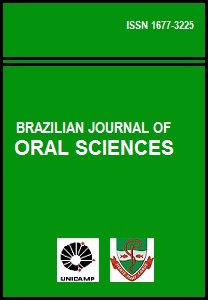Abstract
This study quantified study projects involving human beings analyzed by the Research Ethics Committees (RECs) of University of São Paulo at Bauru, comprising the Hospital for Rehabilitation of Craniofacial Anomalies and Bauru Dental School. The projects were analyzed by retrospective observational study in a six-year period (1998-2003), in all study areas. The sample comprised 1,246 study projects, being 687 at HRAC and 559 at FOB. The numbers of projects analyzed each year at HRAC and FOB were, respectively: 1998 (54, 8), 1999 (72, 38), 2000 (130, 78), 2001 (66, 138), 2002 (191, 195), and 2003 (174, 102). Projects were divided into approved (587, 381), not approved (13, 10), pending (62, 109) and approved with recommendation (25, 59). Projects submitted to the REC of HRAC were mainly related to Speech Therapy (174), followed by Applied Social Work (58); with regard to the REC of FOB, 101 addressed the area of Speech Therapy, followed by Prosthodontics (n=71), Orthodontics (n=69) and Public Health Dentistry (n=65). The main reasons for returning of the projects were: informed consent term; methodology; consent from the institutions; explanation on financial resources; incorrect filling of forms; risk definition; timetable. It was concluded that the role played by RECs is fundamental, since they assure the requirement of autonomy, and the requirement to protect those whose autonomy is reduced.References
Hossne WS, Vieira S. Experimentação com seres humanos: aspectos éticos. In: Segre M, Cohen C. Bioética. São Paulo: EDUSP; 1995, p.127-46.
Vásquez AS. Ética. Rio de Janeiro: Civilização Brasileira; 2000.
Levine RJ. Ethics and regulation of clinical research. Baltimore: Urban & Schwarzenberg; 1986.
Levine RJ. New International Ethical Guidelines for Research involving Human Subjects. Ann Int Med 1993; 119: 339-41.
Sá AL . Ética profissional. São Paulo: Atlas; 1996.
Hossne WS, Freitas CB. Relato do trabalho. Bioética 1996; 4: 15-25.
Sgreccia E. Manual de bioética. São Paulo: Loyola; 1996.
Shannon TA. Bioethics: basics writings on the key ethical questions that surround the major modern biological possibilities and problems. New York: Paulist Press; 1981.
Vargas AC. Problemas de bioética. 3.ed. Rio Grande do Sul: UNISINOS; 2001.
Dassumpção EA. Bioética. Rio de Janeiro: Vozes; 1998.
Kalb PE, Koehler KG. Legal issues in Scientific Research. JAMA 2002; 287: 85-91.
Garrafa V. Bioética e ciência – até onde avançar sem agredir. In: Costa SI, Garrafa V, Oselka G. Iniciação à bioética. Brasília: Conselho federal de Medicina; 1998.
Durand G. A bioética: natureza, princípios, objetivos. São Paulo: Paulus; 1995.
Silva M. Compêndio de odontologia legal. Rio de Janeiro: MEDSI; 1997.
Araújo LZS. Aspectos éticos da pesquisa científica. Pesqui Odontol Bras 2003; 17: 57-63.
Katz J. The silent world of doctor and patient. New York: Free Press; 1984.
Schramm FR, Kottow M. Nuevos desafios para los Comités de Bioéica em investigación. Cuad Med Soc 2000; 41: 1-2.
Botbol BM. The shrinking of human rights: the controversial revision of the Helsinki Declaration. HIV Medicine 2000; 1: 238-45.
Hossne WS A regulamentação de pesquisa com seres humanos como instrumento de controle social. Bioética e saúde pública. São Paulo: Centro Universitário São Camilo; 2003. p.95-111.
Volpato GL. Ciência: da filosofia à publicação. 3.ed. Jaboticabal: FUNEP; 2001.
Vieira S, Hossne WS. Pesquisa médica: a ética e a metodologia. São Paulo: Pioneira; 1998.
The Brazilian Journal of Oral Sciences uses the Creative Commons license (CC), thus preserving the integrity of the articles in an open access environment.

